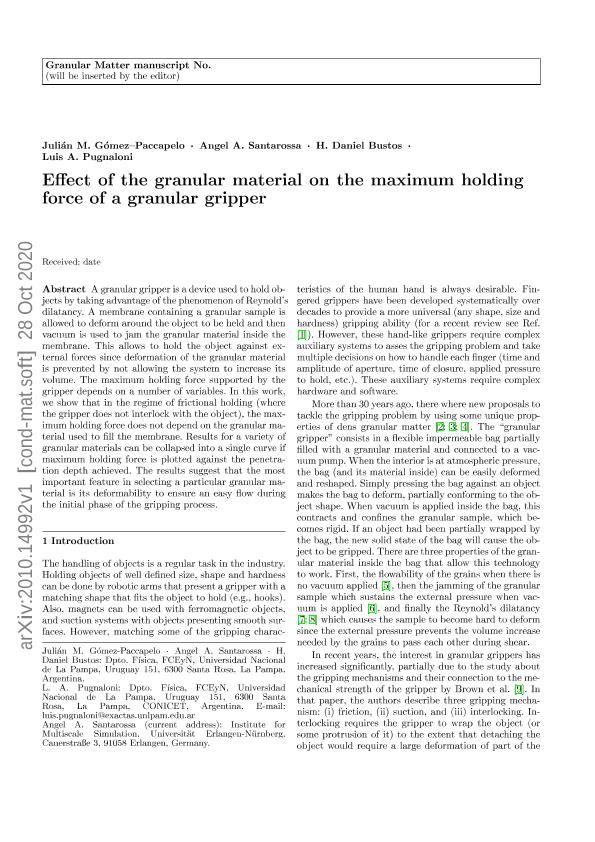Artículo
Effect of the granular material on the maximum holding force of a granular gripper
Gómez Paccapelo, Julián M.; Santarossa, Angel Agustín; Bustos, Horacio Daniel; Pugnaloni, Luis Ariel

Fecha de publicación:
02/2021
Editorial:
Springer-v D I Verlag Gmbh
Revista:
Granular Matter
ISSN:
1434-5021
e-ISSN:
1434-7636
Idioma:
Inglés
Tipo de recurso:
Artículo publicado
Clasificación temática:
Resumen
A granular gripper is a device used to hold objects by taking advantage of the phenomenon of Reynold’s dilatancy. A membrane containing a granular sample is allowed to deform around the object to be held and then vacuum is used to jam the granular material inside the membrane. This allows to hold the object against external forces since deformation of the granular material is prevented by not allowing the system to increase its volume. The maximum holding force supported by the gripper depends on a number of variables. In this work, we show that in the regime of frictional holding (where the gripper does not interlock with the object), the maximum holding force as a function of the penetration of the object in the gripper does not depend on the granular material used to fll the membrane. Results for a variety of granular materials can be collapsed into a single curve if maximum holding force is plotted against the penetration depth achieved. The results suggest that a robotic arm capable of sensing the penetration depth can use this master curve to estimate the maximum holding force at each gripping operation.
Palabras clave:
DILATANCY
,
JAMMING
,
UNIVERSAL GRIPPER
Archivos asociados
Licencia
Identificadores
Colecciones
Articulos(CCT - PATAGONIA CONFLUENCIA)
Articulos de CTRO.CIENTIFICO TECNOL.CONICET - PATAGONIA CONFLUENCIA
Articulos de CTRO.CIENTIFICO TECNOL.CONICET - PATAGONIA CONFLUENCIA
Citación
Gómez Paccapelo, Julián M.; Santarossa, Angel Agustín; Bustos, Horacio Daniel; Pugnaloni, Luis Ariel; Effect of the granular material on the maximum holding force of a granular gripper; Springer-v D I Verlag Gmbh; Granular Matter; 23; 4; 2-2021; 1-6
Compartir
Altmétricas



